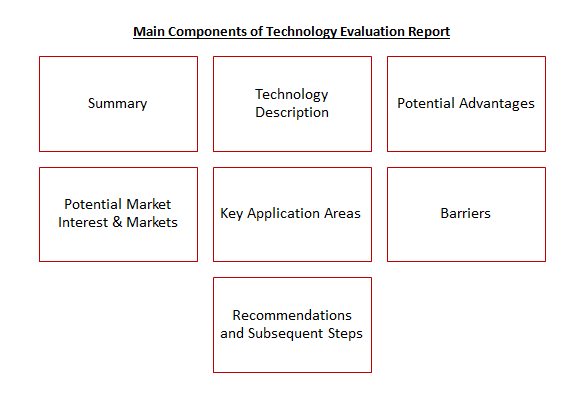How a Technology Evaluation Report Can Save Businesses from Going Under
Statistics reported by Fundera show that nearly 20% of small businesses go belly up within the first year of their establishment. This high rate of failure at the initial stage highlights the fact that running a business is not easy. While these statistics may seem a little daunting, businesses should focus on understanding the factors that lead to the failure of entrepreneurial ventures. A popular method to help companies side-step the challenges and build successful businesses is studying technology evaluation report (TER). In the following article, we will discuss everything about TERs, including how they can save businesses from failing.
Table of Contents
Top Reasons Why Businesses Fail

- Lack of Market Need – The most common reason for the failure of most businesses is their inability to understand the market need. In other words, building products or introducing services that do not cater to the needs of the customer.
- Funding Issues – As time and money are finite, they need to be allocated wisely. Businesses that do not understand the importance of money, or spend it frivolously, or fail to raise funding, often go belly up.
- Ignoring Competitors – Startups like other established businesses must pay close attention to their competition even in the early stages. This is because competitors keep entering the marketspace and outcompeting the startups with their novel products and strategies. Getting outcompeted regularly eventually leads to the failure of startups.
- Pricing Issues – Product or service pricing plays a critical role in the success of businesses. Quite often, businesses find themselves in a dilemma over appropriate pricing. An ideal pricing is the one that covers the costs invested in the product/service and yet, is low enough to attract customers.
- Inadequate Marketing – Startups that develop products but do not market them properly are bound to fail. This is because marketing helps in getting leads that eventually convert to customers that buy products. Marketing campaigns that are run to promote products without knowing the target audience or how to get their attention fall flat and lead to business failure.
- Mis-timed Product Launch – Companies that launch their products before time often risk losing their targeted customers. This is because the customers may not deem such products good enough or this tactic may leave a negative first impression about the company and its products. On the other hand, if companies release their product too late, they might miss the opportunity to enter the market.
Let us look at a case study which is a classic example of business failure due to lack of market need for the product.
Case Study: Why the iPad Racing Wheel Failed
In 2012, Ivaylo Kalburdzhiev (Ivo) came up with a unique idea, which later took the form of the world’s first iPad racing wheel (KOLOS). The wheel could be secured to any table and an iPad could be inserted in it to play tilt games. After conceiving the idea, Ivo took a bank loan to pay industrial designers who worked on the 3D models (3D drawings of the product). He also got the prototypes of the 3D model created that burned a hole in his pocket due to their huge size. Once the product was built, he launched it online at nearly $100 per piece. However, no one bought it.
After facing numerous rejections from both investors and accelerators, Ivo as well as his co-founder were accepted into an accelerator program – Buildit hardware, where the two spent more money and time on the product but still tasted no success. Thereafter, they raised money in a Kickstarter campaign, which was unfortunately stopped too soon.
Now that we know the common reasons for the failure of businesses, let us learn about TERs and how they can save businesses.
How Technology Evaluation Report Can Save Businesses
In simple terms, a Technology Evaluation Report offers crucial information to inventors, small and medium-sized enterprises (SMEs), patent attorneys, or individuals with ideas, for evaluating the impact and value of a technology. Given below are the main components of a TER:

- Summary – The executive summary in a Technology Evaluation Report gives a peek into the information that is offered in the overall report. This section shares information on an invention’s background, market competition, IP competition as well as final assessment of the technology under evaluation.
- Technology Description – In this section, we first cover the broader domain of a technology. For example, in the binder jetting process, the broad domain is additive manufacturing. Hence, we give information on additive manufacturing. This is followed by an in-depth analysis of the technology.
- Potential Advantages – In the potential benefits section, we offer the advantages of the technology under evaluation. For example, if the technology is additive manufacturing (AM), then we mention all the advantages of AM over conventional manufacturing.
- Potential Market Interest & Markets – This section includes narrow as well as broad market research based on the domain. For example, if the technology is binder jetting process, then a broad market research is performed for the technology’s domain, i.e., AM. On the other hand, a narrow market research is conducted for binder jetting. Besides market research, this section also includes exemplary geography mapping analysis that helps in detecting the geographical area from where innovation in the domain originates. This includes the area with the highest number of patent filings, grants, etc. For instance, the main technological innovation for the binder jetting process comes from the US, China, and the European region.
- Key Application Areas – This section of the report includes the technology’s main application areas. For instance, the key application areas for the binder jetting process are energy, electronics, tools & mold making, aerospace, etc.
- Barriers – This section of the report covers two types of barriers. The first hurdle is existing IP. For example, if a company plans to launch a novel technology or use or commercialize a technology, then it needs to identify the type of IP that already exists in the domain that may act as an obstacle to its entry into the market. The second hurdle can be any technical challenge. Companies can use these reports to find out all the technical challenges that they need to tackle.
- Recommendations and Subsequent Steps – A researcher gives a final recommendation based on the information provided in the Technology Evaluation report. Such a recommendation may include information on licensing opportunities as well as a strategy on how to move ahead with a product launch. Besides, the information given in the report can also be used by startup founders or inventors to prepare an investment pitch book.
Information derived from TERs help companies to save time and costs by identifying whether the technology/idea is viable. These reports also identify specific demographics for their product/technology, provide competitor studies to learn from their business strategies, evaluate the competitive advantage of their technology over their competitors, and determine the potential technical or IP risks and opportunities.
Conclusion
Successful businesses cannot be built overnight, and they can certainly not be built without performing thorough technology evaluation studies. Recommendations from these studies that are included in TERs enable businesses to make informed decisions and save them from going under.
In case you are interested in performing technology evaluation studies, we can help you. Sagacious IP’s Technology Evaluation Report (TER) allows you to evaluate a proposed idea/technology for profitability and competitiveness. It helps you gauge the strengths, weaknesses, opportunities, and threats while also steering you further for the next steps. Click here to know more about this service. To watch a webinar on the subject, click here.
-Yogesh Soam (Engineering Searching) and the Editorial Team




